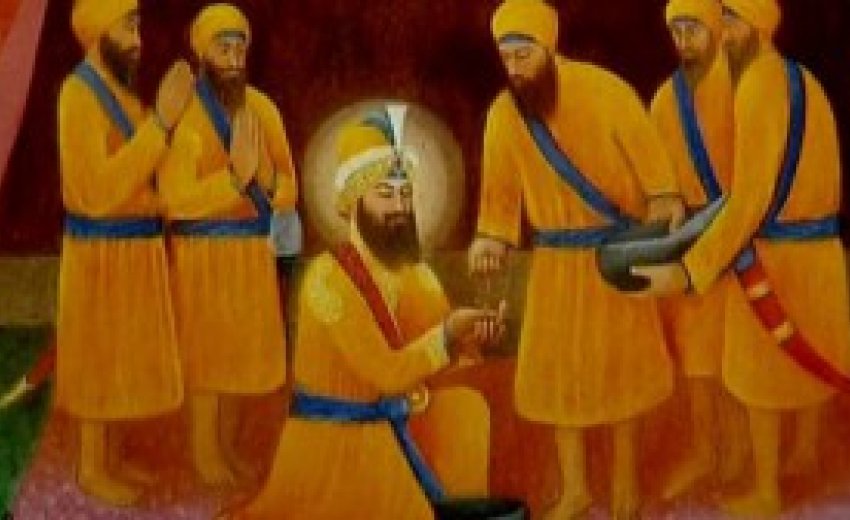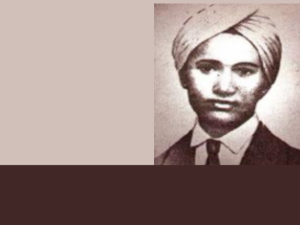The Beloved Five
DR. DALVINDAR SINGH GREWAL
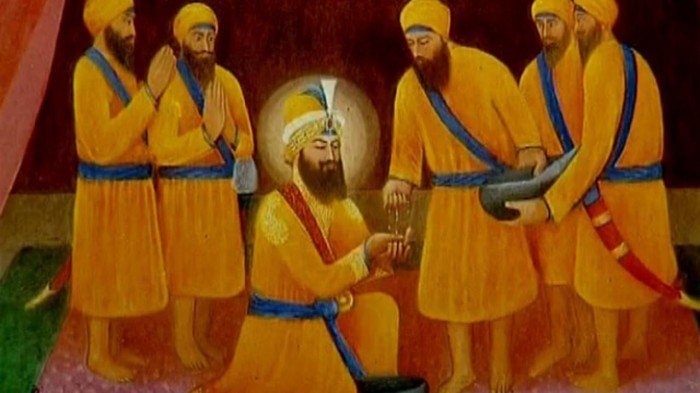
The Panj Piaras Satnam Singh Khanda, Major Singh, Satnam Singh, Tirlok Singh, and Mangal Singh, pronounced a landmark judgment on 22 October 2015, issuing the edict of 'dismissal of five Takhat Heads: Gurbachan Singh (Akal Takhat), Mal Singh (Keshgarh Sahib), Gurbaksh Singh (Damdama Sahib), Iqbal Singh (Patna Sahib) and Ram Singh (Hazoor Sahib) on account of issuing an edict of pardoning Gurmeet Ram Rahim Singh on 24 September 2015 and later on withdrawing the same and also for not appearing before the Panj Piaras to account for the same. They were suspended and posted out of Amritsar by the President SGPC for issuing summons to the five Takhat heads. The Sikh religious establishment seamed in disarray over the dismissal of Takhat Chiefs, suspension of Panj Piaras and acceptance of the edict of the Panj Piaras. With this point in view, the institution of 'Panj Piaras' is discussed in detail to find out the real implications of various edicts and orders.
Panj or panch has originated from Sanskrit word pach(i) which means to spread. When we spread our hand, five fingers are seen. In olden times calculations were based on five fingers. Five thus became an important count. There being frequent fights, selection of five members i.e., two representing each party and one neutral to resolve cases has been an old tradition in India. The village leaders are often called Panch, also taken in the sense of good men and saints, because the appointment is for democratic justice and what ever they decide has to be impartial. The requirement of democratic impartiality and a sense of justice were taken in good sense.
The Gurus lived in a period of foreign rule where the humanity was being crushed under tyranny leashed out to subdue and rule the people under fear. The Gurus not only raised their voice against this sort of rule but also started a system to oppose for which the two Gurus (Guru Nanak and Guru Hargobind) had to bear the rigors of jails and two Gurus (Guru Arjun Dev ji and Guru Tegh Bahadur) had to sacrifice themselves and Guru Gobind Singh had to sacrifice even his sons, father, mother and numerous other close relatives. The later Gurus even picked up swords. However, they all believed in democracy and started such traditions as would lay the foundations of people's rule.
The Tradition of Five
Beloved Ones (Panj Piare) was one such system where the Gurus gave decision making in the hands of the people. The number five was appointed as a representative number when the Sikhs were in large numbers. Everyone was considered equal. The odd number was to ensure that no decision hanged in balance. The Gurus appointed the five beloved ones from amongst the people who could guide not only the people on the lines laid down by the Guru but also who could even correct the Gurus when the decision was difficult or likely to be tilted. They then were close to the Guru not only physically but also spiritually and had nearly the same saintly powers as that of the Guru. One thing was essential however that is, they must be the followers of the Gurus. All the Gurus are stated to be following this tradition.
The supremacy of this tradition was outlined by Guru Nanak:-
Panch parwan panch pradhan. Panche pavh(i) dargah(i) ma:n(u)
Panche sohh(i) dar(i) rajan(u). Pancha ka gur ek dhian(u) ~ (Japu Ang3)
(The five appointed are acceptable as leaders of men. All the five appointed are honoured in the Lord's court. Even if they grace the King's court: their minds are set unto the Lord.)
Gurmat(i) panch sakhe gur bhaee.( Mahlla 1, Ang.1041)
(By the Guru's gospel the appointed five become disciple-brothers.)
Bhai Gurda:s confirmed these views:-
Ik(u) sikh(u) dui sa:dh sang(u) panjeen Parmeshar(u) (Var 13)
(If One Sikh meets another, it becomes a saints' company, and if five join together, the
Lords descends in them.)
Parmesar hai Panj Mil(i) lekh alekh na keemat(i) payee.
Panj milai parpanch taj(i) anhad sabd sabd(i) liv layee.
Sadh sangat sohan(i) gur bhayee. (Var 29)
The five joined shrug off all falsehood and get tuned to the True Lord's Name.
They grace the congregation of the saints.)
Sanmukh(i) mil(i) panch a:khian(i) bird(u) panch parmesur(u) pa:see.
Gurmukh(i) mil(i) parwan panch sadh sangat(i) sachkhand bilasee.
(The meeting of five good persons only is considered as of the appointed five,
and those appointed five only reach the True Lord.
If these appointed five are Guru's true followers they are acceptable to the congregation of saints
and they guide them to the True bliss.)
According to Bhai Kahn Singh Nabha 'the Beloved Five' have been appointed from the times of Guru Nanak to date. He lists the names of Panj Piare of Guru Arjun and Guru Tegh Bahadur in Mahan Kosh (P.791). These names were however not permanent and changed with time, e.g., when Guru Arjun Dev ji was called to Lahore by Jahangir, the Guru selected Bhai Bidhi Chand, Paida, Pirana, Jetha and Salo to go with him to Lahore (Giani Lal Singh Sangrur: Guru Khalsa Twareekh p. 278). Similarly at Chamkaur Garhi the Panj Piaras who gave the decision that the Guru should quit the Garhi were Bhai Daya Singh, Bhai Dharm Singh, Bhai Sant Singh, Bhai Sangat Singh and Bhai Man Singh (Bhai Gyan Singh Gyani: Guru Khalsa Twareekh Part II p.1017). The situation is described by Bhai Gyan Singh as follows: 'The Guru made Sangat singh to wear all his dress including the Kalgi and after prayer said, "Guru Khalsa, Khalsa Guru. Brother Sikhs. From today onwards I hand over the position of Guru to the Khalsa. Consider me present in the Five. Name of Five Singhs is Khalsa. As per Adi Granth Five are the accepted one as the Leaders. The five are honoured at the Lord's Court. They should be not less than five; may be more. Five Singhs are the Saints of the Saints and Gurus of the Gurus. That was why I have made them same as me by imparting them Amrit. If the five Singhs pray with pure heart whatever the task it will be completed."
The tradition of imparting Pahul by Panj Piare was first started by Guru Hargobind. Kesar Singh Chhibber records in 'Bansawli Nama Dasan Patshaheean Ka' : 'Samat sola sau athhatar beete. Guru Tegh Bahadur Mata Nanaki de udron janam leete…(107)
Mela visakhi da aya. Sangat(i) bahut aaee. Lain gur deekhia lagn(i) charnee jayee. Tan sahin cha:la: aisa thehraia. Sikhan nun a:p rasni samjhaia.(108) Wa:see wich jithe hoe dharmsal(i). Sikh mil baithan prem muhabbat nal(i). Shabd sakhi Granth pothee padie. Keertan katha Gur charcha karie. (109)…
Hachha sucha katora kar(i) pa:nee pa:na. Panj sikhan de angoothhe upar pa:nee wahana.(110) Tis pa:ni upper(i) Jap panj paodian padhna. Fer panj paudian anand ucharna. So pa:nee sikh nun charnmrit kar dena. Kar Arda:s parsa:d(i) wartai laina.(111)'(p.67)
(Samat 1678 passed. Guru Tegh Bahadur was born to Mata Nanaki …(107). On the Vaisakhi fair Sangat gathered in number, to take fellowship by touching Guru's feet. The Sahib(Sri Guru Hargobind Ji) then acted differently and explained the congregation in his own words, "Whereever there is Dharmsal in the settlements, the sikhs must sit together with love and affection and read Shabad from Granth Pothee (A:d(i) Granth). They must sing hymns, give descriptions and discuss about Gurus. ….Take a clean good utensil (Katora) and put water in it. The water must then be put on the Thumb of the right foot of the Five Sikhs. On that five steps of Japu followed by five steps of Anand should be recited. Water so prepared much be given to Sikhs as Charnamrit and should be distributed after Prayers."
The above tradition of Panj Piare was also followed by Guru Gobind Singh though with certain modifications which is being followed till date. The details are given below:
On the Sangrand of Vaisakh 1755 (30 March, 1699 A.D.) at Anandpur in the congregation of around 5,000 devotees, Guru Gobind Singh came out on the dais with a naked sword and demanded for a Sikh to offer himself for sacrifice. It caused deadening silence among the people and a fear gripped many. It was Daya Ram Sobti Khatri who came out to offer himself for the sacrifice. He showed no fear of death at the hands of the Guru as he himself had totally committed to the Guru and his ideals. As he led, four more Sikhs, Muhkam Chand of Dwarka, tailor by trade, Sahib Chand of Bidar Karnatak, barber by trade, Dharam Chand of Hastinapur Utter Pradesh and a farmer by trade and Himmat Chand of Jagannath Orissa, water carrier by trade followed and offered themselves for the sacrifice one after the other.
After performing the rituals, the Guru asked them to have bath washing their hair, and handed over a wear which included Kangha (a wooden comb) for the Kesh (hair), Sarb Loh Kada (an iron bracelet) for the wrist, Kachha (a pair of shorts) and Kirpan (a sword) in a cloth belt to be worn along with a kesri (pink) dress and double blue turban. Guru too wore the same dress and came on the dais in front of the congregation surprising everyone seated. The Guru declared, "Dear Sikhs, in the tests of Guru Nanak only one Sikh Bhai Lehna (Guru Angad) passed the test and Guru Nanak closeted him and gave the name Angad. This time these five Sikhs have passed the test of sacrifice. I give them the position of 'Panj Piare' (The Five Beloved Ones). They shall be ever remembered so. Now on wards, their name will always be included in the prayer which we do two times a day. Whenever the Parsad of three equal items (Ghee, floor and sugar) is prepared a share will be taken out for them after the Guru's share."
Thereafter, the Guru got prepared the 'Nectar' from the waters of Sutlej mixing the various items with a 'khanda' (two sided sword) while reciting Japuji Sahib. Mata Jeeto when inquired as to what was being done, was told that the nectar is being prepared. She brought 'patashas' and poured into the Batta in which the nectar was being prepared. The Guru carried on continuous recitation of Japuji followed by Jaap, Sawaaiye, Chaupai and Anand Sahib. After the preparation of Amrit, the congregation joined the Guru in Prayer (Ardas) and shouted the slogan, 'Nanak Naam Chardi Kala, tere bhane sarbat ka bhala'
Thereafter, he put a drop on the edge of the 'khanda', put five drops into his own mouth and called 'Wahe Guru ji ka Khalsa Waheguru ji Fateh' five times….Thereafter the Guru gave the pahul of Khanda to Bhai Daya Ram and the other Piaras one by one making them to sit bent on one knee…. Guruji then attached Singh to his name as well as the names of Panj Piare." (Guru Kian Sakhian, p.111-115)
The Bhatts recorded the event of initiating the Five Beloved Ones at Anandpur Sahib in their Wahi as follows:-
'Guru Gobind Singh, the Tenth Guru, son of Guru Tegh Bahadur gave khande da pahul to five Sikhs on the the day of Vaisakhi Samwat Seventeen hundred fifty five and called them SINGH. First Daya Ram Sopti Khatri of Lahore stood up, followed by Mohkam Chand Chheepa of dwarka, Sahib Chand Nayee of Bidar (Zafrabad), Dharm Chand Jwanda Jat of Hastinapur, Himmat Chand Jheewar of Jagan Nath turn by turn.
All were then dressed in blue. He himself too wore the same. (Bhatt Wahi Bhadson, Pargna Thanesar)
These traditions set by Guru Gobind Singh have been followed thereafter to-date and have been included in Sikh Rehat Maryada adopted by Shiromani Grudwara Parbandhak Committee on 3-2-1945.
- The names of Panj Piaras is included in the Prayer of the Sikhs.
- The parsad is first given to Panj Piaras and then to the sangat.
- Amrit can be imparted by Panj Piare only. One of the Panj Piare explains the tenets of Sikhism before the Amrit is imparted.
- Only Panj Piare give the Moolmantra and beej Mantra Wahiguru to the person taking pahul.
- Only Panj Piaras are authorised to declare punishment to the non-followers of Sikh tenets. They also are authorised to excuse any one on completion of punishment.
The names of 'the beloved ones' accepted by the Gurus are as under:
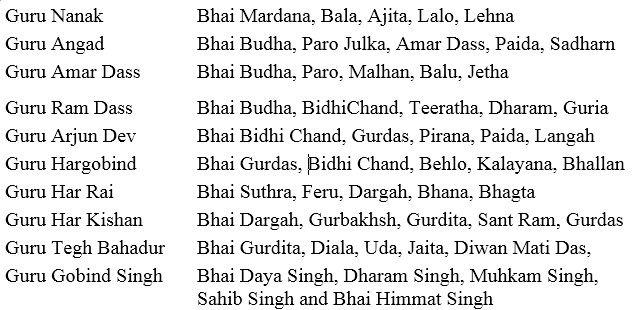
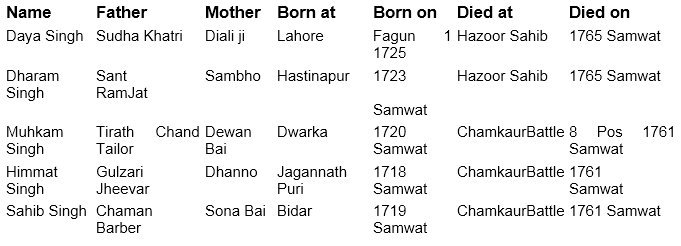
These Panj Piaras gave account of themselves in various battles. In the Battle of Chamkaur, all of them were with Guru Gobind Singh. The layout of the Chamkaur Garhi is drawn here based on Guru Kian Sakhian by Swaroop Singh Koshish (gist of Bhatt Wahis) showing Panj Piara's closeness to Guruji. Bhai Mohqam Singh, Sahib Singh and Himmat Singh laid down their lives fighting against the Mughals at Chamkaur while Bhai Daya and Dharam Singh remained with the Guru till he attained the eternal light. The Panj Piaras at Garhi Chamkaur gave the edict to the Guru to escape the Garhi to continue the fight further. Guru Gobind Singh obeyed the edict and left the Garhi. Bhai Daya Singh and Bhai Dharam Singh breathed their last at Nanded Sahib in Samwat 1765.
Some of the other important events connected with Panj Piare known in Sikh History are given below:-
- At Naraina Gaon in Rajasthan when Guru Gobind Singh bowed before the monument in memory of Dadu Ram Bairagi, Panj Piare led by Bhai Daya Singh declared The Guru as Punishable and gave the punishment of Rs 125/- the amount which the Guru paid appreciating the stand of the Khalsa and declared that the Khalsa has now become Pure and acceptable. (Guru Kian Sakheean p.181)
- On Samwat 1765 Kartik Sudi Teeuruj, Guru Gobind Singh sent five Singhs Bhai Bhagwant Singh, Koer Singh, Ba:z Singh, Binod singh and Kahn Singh with Baba Banda Singh Bahadur after appointing him Jathedar of Panth, with the instructions that 'Jahan bheed pade pa:nchon se arda:s karana" (Guru Kian Sakhian p.189)
- Bhai Mani Singh felt that Sri Guru Granth Sahib, the key scripture is difficult to handle by the rural Sikhs hence must be prepared in Parts. When the Khalsa came to know that Bhai Mani Singh has got Sri Guru Granth Sahib separated, they gathered and gave an edict that each part of Bhai Mani Singh's body should also be separated as he has separated Shri Guru Granth Sahib. He was to be removed from Khalsa Panth. When Bhai Mani Singh came to know of the punishment, he approached the Sangat to relieve him of the second punishment i.e., removal from Sikh Panth and prayed that even though his parts may be separated his Sikhism must not be separated. Panj Piare were then elected who then gave the verdict that Bhai Mani Singh's "Sikhism will remain intact". When Bhai Mani Singh was asked by Nawab of Lahore as to 'what punishment will you like' he specifically chose to be cut into parts and was put through this. (Panth Prakash p.295-300). Bhai Mani Singh's acceptance of the will of Panj Piare is a trend setter.
- When Bhai Taru Singh skin of the head were removed (Khopri luhai), the Nawab of Lahore asked Bhai Taru Singh, "You had said that you will live till you have your hair, why are you alive then? You have told a lie." Bhai Taru Singh replied, "My hair is with my skull, in which my life exists, till I take you along by hitting you with shoes (Joota). You will go to hell. Now your urine and latrine are stopped and be ready for it." The Nawab faced the problem of stoppage of urine and latrine immediately thereafter and life became like hell. He tried all medicines and worshipped all Peer-Paigambar, but he got no relief. He then realised the effect of the curse of Bhai Taru Singh. He called the Singhs of the city and requested them to approach Bhai Taru Singh to relieve him of the curse. Bhai Taru Singh did not relent. Bhai Subheg Singh who was on an official post was approached by the Nawab with a request that 'now only the Khalsa can be the redeemer'. He even kept his turban at Subheg Singh's feet. Bhai Subheg Singh again went to Bhai Taru Singh and explained how the Nawab kept his truban at his feet to get excused. Bhai Taru Singh then relented saying, "It is the Khalsa who can relieve the Nawab of the curse". Bhai Subheg Singh went to Nawab Kapoor Singh at Amritsar who called a congregation. After discussion, it was resolved that the Guru has set the tradition that 'even if the enemy comes for protection, he will be saved.' The Nawab of Lahore must be relieved of the curse. Five Singhs were then selected, who gave this decision, "Shoes of Bhai Taru Singh must be touched on the head of Nawab after a touch from the hands of Bhai Taru Singh. The permission of Bhai Taru Singh is a must." Bhai Subheg Singh took this decision to Bhai Taru singh and the Nawab. Both agreed to the decision. The Nawab was relieved of the pain but died before Bhai Taru Singh breathed his last being in the beheaded state for 22 days. (Sri Guru Panth Prakash p. 370-380)
- Similarly when Kapoor Singh was offered the Nawabship, he first touched the presentation to the feet of the five beloved ones and then accepted it. (Sri Gur Panth Prakash, p.286) These five beloved ones were Bhai Hari Singh, Baba Deep Singh, Sardar Jassa Singh Ramgarhia, Bhai Karam Singh and Sardar Budh Singh (Satbir Singh: Sada Itihas: p.138)
- Punishment of lashes to Maharaja Ranjit Singh by Panj Piare performed by Akali Phoola Singh on Maharaja's adopting Non-Sikh activities.
The Panj Piara tradition has been regularly followed in Sikhism thereafter and decision making or leading the Sikhs in times of trouble or otherwise became the key charter of the Panj Piaras in addition to performing the ceremony of imparting Amrit to Sikhs as per Sikh Rehat Maryada. Religion is a matter of faith and not so much of a reason.
In view of this, the edict issued by Panj Piaras carries a unique weight. To what extent are the affected Takhat Chiefs obligated to respond to the Panj Piare? It must be kept in mind that, in the past, it was the faith in the Guru and unflinching loyalty to the point of offering one's life to the Guru which made them to be accepted as Panj Piaras. Do the Panj Piaras have any of the same authority that they had in the past? Or has this institution become simply a ceremonial one? Or has this institution become simply a ceremonial one?
------------
Bibliography
Bhagat Singh A History of the Sikh Misls, Punjabi University, Patiala,1993
Bhai Santokh Singh Shri Gur Partap Suraj Granth, Bhasha Vibhag, Punjab, 1976 (Hindi)
Bhai Gurdas Varan, Amritsar, June 1964 (Punjabi)
Bhai Sukha Singh Gur Bilas, Bhasha Vibhag, Punjab, Patiala, 1970 (Hindi)
Bhai Kahn Singh Nabha Gurmat Martand, 2 Vols. SGPC, Amritsar, April 1983 (Punjabi)
-do- Mahan Kosh, National Book Shop, Delhi, 1995 (Punjabi)
Bhai Ratan Singh Bhangu Sri Gur Panth Prakash, Ed. Dr. Jeet Singh Seetal, SGPC Amritsar, 1984. (Punjabi)
Giani Gian Singh Twareekh Guru Khalsa 2 Vols., Bhasha Vibhag, Punjab, Patiala, 1993. (Punjabi)
Giani Lal Singh Sangrur Guru Khalsa Twareekh, Lahore Book Shop, Ludhiana, 1955 (Punjabi)
Harbans Singh (Ed.) The Encyclopaedia of Sikhism, Punjabi University, Patiala, 3 Vols., 1996-7 (Eng)
Kesar Singh Chhibber Bansawli Nama Dasan Patshaheean Ka, in Parkh, Vol II, 1972, Punjab University,Chandigarh (Punjabi)
Piara Singh Padam & Giani Garja Singh (ed.) Guru Kian Sakhian by Swaroop Singh Koshish, Kalam Mandir, Patiala,1983 Pbi
Sainpat Sri Gur Sobha, Ed Dr. Ganda Singh, Pbi
S.G.P.C. Sikh Rahit Maryada, Amritsar, 1993, Pbi
Teja Singh (Principal) & Dr Ganda Singh : Sikh Itihas (1469-1765), Punjabi University,
Patiala,1985 Punjabi
